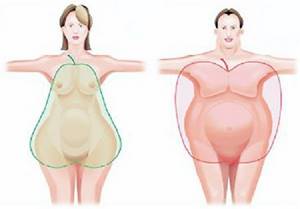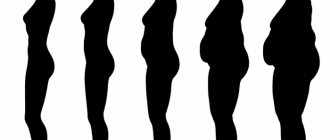Causes of grade 1 obesity in children
The disease, characterized by an increase in body weight, has a polyetiological nature. In this case, the main factor causing obesity is considered to be excess calorie intake.
Stage 1 obesity, which develops in children, is caused by:
- eating large amounts of junk food;
- low physical activity;
- heredity;
- pathological disorders in the body;
- stressful conditions.
It has been noticed that if the father and mother suffer from excess weight, in 80% of cases the child will also face a similar problem. And if only one of the parents, the risk of gaining weight is about 30%.
First-degree obesity can appear, for example, due to a brain tumor, hypothyroidism, or Down syndrome. Sometimes the trigger for the development of obesity is negative emotions associated with a certain period of life or with a tragedy in the family.
Obesity of the 1st degree in children is often perceived by adults as a normal phenomenon, which can subsequently result in serious complications.
If we determine the main reasons by age, then in a child, extra pounds usually arise as a result of improperly organized nutrition, and in primary schoolchildren and teenagers, the disorder is caused by non-compliance with the daily routine, a sedentary lifestyle, overeating and stress.
What tests to take if your child is obese?
The pediatrician prescribes a biochemical blood test for all overweight children. It includes:
- Lipidogram to identify excess cholesterol, triglycerides, the predominance of low-density complexes and a decrease in high density. This condition is called dyslipidemia, it reflects a disorder of fat metabolism.
- Liver enzymes ALT and AST in order to eliminate organ obesity (fatty steatosis). It can develop into steatohepatitis and cirrhosis. High ALT levels are important.
- Glucose tolerance test. Blood test on an empty stomach and after a sugar load. Finding an increase in one of these glucose levels is considered prediabetes. It is also possible to detect overt type 2 diabetes at this stage.
Watch the video about diagnosing obesity in children:
It is necessary to take hormone tests. They are usually prescribed by an endocrinologist after a survey and examination. If he suspects secondary weight gain due to hormonal imbalance, then the following are indicated:
- in case of chromosomal diseases - proinsulin, parathyrin of the parathyroid gland;
- for hypothyroidism (low thyroid function) - thyroid-stimulating hormone of the pituitary gland, thyroxine, triiodothyronine;
- hypothalamic disorders - IGF 1 (insulin-like growth factor), prolactin, somatotropin (can be combined with a provocative test);
- monogenic form (gene mutations) – leptin, adrenal cortisol, pituitary corticotropin;
- hypercortisolism (increased activity of the adrenal cortex) - daily urine for cortisol, throughout the day cortisol and corticotropin in the blood, dexamethasone test;
- disturbance of puberty, increased growth of hair on the face and body in girls, cycle failure - testosterone, anti-Mullerian hormone, luteinizing and follicle-stimulating hormone, sex steroid-binding globulin;
- increased blood pressure - renin, aldosterone, blood, catecholamines and their metabolic products in daily urine.

BMI (body mass index)
Classification
Taking into account the origin, the disease is divided into 2 types - primary and secondary.
In turn, the primary is:
- exogenous-constitutional (implies genetic factor);
- nutritional (obesity develops against the background of appropriate eating habits).
As for the nutritional form, it is usually observed in children under 3 years of age, in preschoolers (5-7 years old) and during puberty (beginning at 11-12 years old).
Girls are more likely to be overweight, which is directly related to earlier puberty.
The secondary type of pathology in many people develops due to disturbances in the functioning of the thyroid gland, adrenal glands or ovaries (in girls).
The child is very fat: what to do, how to lose weight for children
If the child is very fat, not all modern parents know what to do. Panic begins, confusion arises. Meanwhile, the first thing an overweight child should do is pay attention to the nutritional system. For the first course, serve teaspoons. Then the plate will be emptied not in 15-20 “appointments”, but in 40-50. Repeated movements of the hand with a spoon from the plate to the mouth “deceive” the brain, which believes that a large amount of food has already been absorbed and it is full. Overweight children can lose weight much faster than adults, since they have accelerated metabolism.
Use blue or green utensils for food. Nutritionists and psychologists have noticed that these colors suppress appetite.
Have a fasting day once a week. It is especially useful on the eve or after a holiday accompanied by a rich feast. Do not invite your child to the table “for company” when he does not feel hungry. The more eaters there are at the table, the more food each eats.
Symptoms of obesity in children
The disease at the initial stage does not differ in obvious signs, while some parents believe that a little obesity will not harm the child. The first stage of obesity in adolescents and younger children is accompanied by an almost uniform distribution of body fat.
Among the characteristic manifestations:
- protrusion of the abdomen;
- folds on the body;
- stretch marks on the skin.
Depending on the causes of obesity, the child may be bothered by symptoms that are not related to appearance (headache, increased blood pressure, increased sweating, insomnia, etc.).
Table of norms for weight and height of children under 17 years of age
The World Health Organization (WHO) has established standards for body weight and height in childhood until the age of 17. Some differences in performance between girls and boys should be noted.
This is explained by the existence of certain physiological characteristics.
| Age category (number of years) | Girls | Boys | ||
| Weight, kg) | Height (cm) | Weight, kg) | Height (cm) | |
| 1 | 9.3-11.8 | 74-80 | 10-12.7 | 76-83 |
| 2 | 10.9-14.1 | 82-90 | 11.8-14.3 | 85-92 |
| 3 | 13.3-16.2 | 91-99 | 13.2-16.6 | 92-99 |
| 4 | 13.8-18.0 | 95-105 | 14.8-19.4 | 98-107 |
| 5 | 16.0-20.6 | 104-114 | 16.5-22.7 | 105-116 |
| 6 | 18.2-24.6 | 111-120 | 18.7-25.2 | 111-121 |
| 7 | 20.5-28.5 | 113-117 | 20.6-29.4 | 118-129 |
| 8 | 22.4-32.3 | 124-134 | 23.2-32.6 | 124-135 |
| 9 | 25.2-36.8 | 128-140 | 24.7-36.5 | 129-141 |
| 10 | 27.9-40.5 | 134-147 | 28.4-39.1 | 135-147 |
| 11 | 30.5-44.6 | 138-152 | 29.0-42.2 | 138-149 |
| 12 | 36.5-51.4 | 146-160 | 33.7-48.5 | 143-158 |
| 13 | 40.4-56.5 | 151-163 | 40.6-57.1 | 149-165 |
| 14 | 44.6-58.5 | 154-167 | 43.8-58.4 | 155-170 |
| 15 | 47.0-62.3 | 156-167 | 47.8-64.9 | 159-175 |
| 16 | 48.8-62.5 | 157-167 | 54.5-69.8 | 168-179 |
| 17 | 49.3-63.6 | 158-168 | 58.0-75.5 | 170-180 |
To check the table, you must correctly measure the child's height. He should stand straight against the wall, not slouching, with his feet tightly together. Only the shoulder blades, buttocks and heels are in contact with the wall. The head must be held so that the edge of the lower eyelid and the upper part of the auricle are on the same horizontal plane.
Diagnosis of obesity in children
During the examination, the doctor clarifies the child’s nutritional characteristics, for example, at one year or at 8 years old, how active he is and whether there is a predisposition to weight gain.
The following indicators are also recorded:
- body weight;
- growth;
- waist and hip circumference;
- BMI.
Below is a table that will help determine the degree of obesity in childhood, depending on how much body weight differs from normal values:
| Deviation indicator | Disease stage |
| 15-24% | First |
| 25-49% | Second |
| 50-99% | Third |
| More than 100% | Fourth |
In addition, gender is taken into account. For example, normal weight indicators for a 10-year-old boy will be slightly different from those for a girl. If the stage is determined using BMI, then with 1 degree of pathology its value will be above 30.
You will also need to undergo blood biochemistry and check your hormonal profile. If necessary, the doctor refers to an ultrasound of the thyroid gland, MRI of the pituitary gland, and electroencephalography.
Which doctor should I contact?
Obesity is detected by a pediatrician who monitors the child at his place of residence. He conducts an examination and initial examination, issues a referral for general clinical blood tests. In order to establish the cause of weight gain, a consultation with a pediatric endocrinologist will be required.
Since obesity creates an increased load on the digestive organs, nervous system, heart, kidneys, if changes are detected at the first stage, the pediatrician recommends consultation with a gastroenterologist, neurologist, cardiologist and, if necessary, other specialists.
We recommend reading the article about diabetes insipidus in children. From it you will learn about the causes of diabetes insipidus in children, signs and symptoms of the disease, diagnosis and treatment of diabetes insipidus in children, as well as folk remedies for therapy.
And here is more about the adrenal glands and excess weight.
Treatment of grade 1 obesity in children
Since the initial development of the pathology is not accompanied by pronounced symptoms, weight correction is usually carried out through diet and moderate physical activity. At the same time, parents themselves should be prepared to revise their lifestyle, which will allow children to cope with excess fat more easily and quickly.
Nutrition
If a child is diagnosed with stage 1 obesity and the doctor has explained in detail what to do first, you should be patient to achieve the desired results.
To gradually lose weight, you must adhere to the following recommendations regarding nutrition:
- the child should eat small portions 5-6 times a day, and with each subsequent meal it is worth reducing its calorie content;
- the daily menu includes more protein, fiber, vitamins, and minerals;
- the list of prohibited foods includes foods with fast carbohydrates;
- The amount of fluid consumed should correspond to the age norm.
On the recommendation of a nutritionist, you can arrange fasting days. Hunger strikes are strictly contraindicated.

Body weight is monitored every day.
If weight gain stops, then with long-term dieting and as the body grows, you can observe the disappearance of excess fat deposits.
Physical exercise
Proper nutrition should be combined with physical activity. For example, dancing is a great way to speed up weight loss. The main thing is that children enjoy this activity.
Also suitable are visiting the pool, athletics, cycling or skating.
When it comes to young children, a variety of outdoor games are a good opportunity for them to burn calories.
Drug treatment
Drugs may be prescribed when obesity has become a symptom of another disease. Only a doctor is involved in selecting medications and preparing dosages. In other cases, obesity at the initial stage is eliminated due to the restructuring of the nutritional regimen and physical activity.
It is also important to understand that treatment alone without diet and exercise will be ineffective.
How can you make a child and help children lose weight at home?
Before you force your child to lose weight, teach everyone in the household to eat slowly, chewing food thoroughly. Eating in a hurry “on the go”, food swallowed in large pieces that is not moistened with saliva, injure the mucous membrane of the esophagus, and place a heavy burden on the stomach, requiring great effort from it to digest. Before helping your child lose weight, it is important to understand that quickly and abundantly filling the stomach with a variety of foods does not bring satisfaction; the feeling of fullness does not occur for a long time.
On the contrary, thoroughly chewing food, in addition to having a beneficial effect on the stomach, also provides another service to its owner. When chewing food entering the oral cavity for a long time (20-30 chewing movements), a small volume is enough to create a feeling of satiety. Long-term operation of the chewing apparatus contributes to the slow filling of the stomach, the gradual release of gastric juice, which creates the illusion of a long busy period in the stomach, and it sends impulses to the brain: “I am full.”
This is one of the basic rules for those who want to lose weight. By understanding and mastering how children can lose weight at home, you can establish a healthy diet for the whole family.
Treatment with drugs
In the case of drug treatment, you need to be extremely careful. You should carefully study the instructions for each drug and follow your doctor’s recommendations. Treatment of obesity in infants begins from the third stage. Therapy includes vitamins for infants and approved drugs that affect weight loss. Babies definitely need calcium: in addition to its effect on excess body weight in a newborn, this drug prevents the development of rickets.
Children may be prescribed physical therapy, which includes mud therapy, swimming in mineral baths, aerotherapy, and hydrotherapy.
Diagnostic methods
In most cases, female obesity can be determined visually - by the deposition of fat on the buttocks, thighs, and lower abdomen. The figure takes on the shape of a pear. But mixed forms of obesity are possible, in which there is an enlargement of the abdomen (apple-shaped figure) and breasts.

Scheme: a man has an apple-type figure
In this case, a diagnosis can be made using the following methods:
- BMI calculation – more than 25 kg/m2;
- blood test for estrogen and testosterone levels;
- MRI or ultrasound of organs, especially the liver, to detect visceral obesity.
The last factor plays a particularly significant role. Visceral fat threatens the functioning of the body, so the fight against obesity begins with eliminating this particular problem.
Identifying visceral fat will also help a man in psychological matters. Patients often give up in the fight against female obesity only because all measures do not give visible results. But changes first occur in the area of internal organs, especially the liver, so you should be patient and not deviate from the chosen treatment tactics.
Hormone that suppresses appetite.
Let's return to the primary type of obesity, which is formed by overloading the diet with fats and carbohydrates. Recent studies show that overeating in this case is explained by a lack of the hormone leptin. Leptin is an appetite suppressant hormone. It is produced by adipose tissue and the blood flow is sent to the highest center of hormonal regulation, the hypothalamus.
Such leptin deficiency can be hereditary or acquired, but in any case it leads to the fact that the hypothalamus does not perceive saturation signals and this can be the cause of childhood and adolescent obesity.
Tests for excess weight: list and explanation
If the usual methods of combating excess weight, such as sports, diet, “unloading” the nervous system, do not help for at least two to three months, doctors recommend taking a series of tests.
You have been following a diet for a long time, exercising, cleansing your body, but your body weight has not decreased, perhaps the reason for excess weight is not in nutrition, but in your health?
Poor functioning of the thyroid gland, slow metabolism, disturbances in the production of glucose and insulin, and high levels of cortisol lead to obesity. Diagnosing the cause of these problems using laboratory tests will help you cope with excess weight and avoid serious health problems.
Recommended for:
A cause for concern is the body mass index, which does not change even during fasting or difficult sports activities. With overweight, the BMI is 25-29.9 units, and with obesity it exceeds 30.
The cause of obesity is hormonal disorders in the body, metabolic disorders, endocrine diseases, a characteristic feature of which is excess weight gain.
Excess weight provokes the occurrence of a number of diseases: diabetes mellitus, diseases of blood vessels and veins, including atherosclerosis and varicose veins, becomes one of the factors of cancer, causes severe depression, asthma, and heart attacks.
Preparation for analysis
Tests are the easiest and fastest way to check your health. Testing is carried out in the form of venous blood sampling.
It doesn’t matter what tests you have to take, you need to prepare for them:
- The best time to donate blood is early morning, from 7:30 and no later than 11:00;
- 12 hours before blood sampling, do not eat;
- Two weeks before the procedure, do not take medications (if this is not possible, notify your doctor about taking medications that can affect the tests);
- For a couple of days it is better not to eat fried and fatty foods, not to drink alcohol;
- It is important to give up cigarettes an hour before and not smoke for at least another hour after the procedure;
- Half an hour before blood sampling, rest a little and avoid any stress or stress.
Types of analyzes
Laboratory tests required for excess weight are divided into several groups. Each group allows you to identify different reasons for weight gain.
For infection
First of all, they check for the presence of hepatitis C. The hepatitis virus affects the functioning of the liver, causes a weakened immune system and the formation of excess weight with each relapse of the disease. They also take tests for HIV and syphilis.
STDs do not affect body weight, but are prescribed as mandatory in medical studies and are recommended to be taken at least once a year.
For hormones
Obesity is a good reason to get tested for hormones. First, the thyroid gland and the functioning of this organ are checked. The main purpose of the test is the hormone triiodothyronine T3, produced by the thyroid gland.
Based on triiodothyronine, another hormone is synthesized - T4, which regulates the consumption of oxygen by cells, the absorption of vitamins and body weight growth.
The hormone also regulates the concentration of cholesterol in the blood, the excess of which negatively affects weight, heart function and blood vessels.
Healthy hormone levels are calculated based on the patient's age. Thus, the amount of T4 remains unchanged throughout life, but the content of T3 decreases with age.
For enzymes
After hormones, the levels of ALT and AST enzymes are checked. A discrepancy between the level of enzymes and the norm indicates any, even minimal, disturbances in the functioning of the liver. The level of enzymes increases with the development of infectious diseases. The same hepatitis affects a sharp increase in ALT.
The amount of protein is determined to find out the condition of the liver and assess the body’s performance in terms of the uniform distribution of fat cells. To do this, analyze the total amount of globulins and albumin that are in the body.
General studies
Be sure to carry out general tests and analyze hemoglobin levels. Blood cells are responsible for transporting nutrients and oxygen to every cell in the body. The quality of transport of nutrients directly affects the overall health, the same principle applies to the level of leukocytes and red blood cells.
A decrease in the number of blood cells indicates a possible disruption of the internal secretion organs. Such disorders, coupled with poorly functioning kidneys or the development of infections, cause obesity.
Other studies
If you are overweight, an additional study is the biochemistry of obesity, in which the amount of cholesterol is separately assessed, because its content also depends on hormonal levels.
Deviation of cholesterol levels from the norm indicates disruptions in metabolism, which is directly related to weight gain and the inability to lose weight through diets and exercise.
Additionally, the glucose content is determined, which also affects metabolism.
Interpretation of analyzes
The levels of hormones, enzymes and other substances are determined by the limits of acceptable amounts. Doctors regard a deviation from the norm as a violation of the body’s vital functions:
- Glucose demonstrates the quality of carbohydrate metabolism; glucose norm is 3.89-5.83, deviations from the values help diagnose diabetes mellitus;
- The hemoglobin norm is 120-140, the norm changes with age and depends on gender; hemoglobin is used to estimate the chance of developing diabetes complications even with normal sugar levels;
- Insulin (normal 3.9-6.4) is a pancreatic hormone that “monitors” the amount of sugar in the blood; its deficiency becomes the basis for the most severe form of diabetes;
- Leptin (normal 3.6-10.9) is formed in fat cells and regulates energy metabolism and controls body weight;
- Prolactin (norm 53-360) affects the development of obesity; the higher the level of prolactin, the higher the risk of developing extra pounds; the substance directly affects the synthesis of fat cells;
- Acceptable cholesterol (general norm 3-6) – the norm depends on gender, affects the “clogging” of blood vessels, which slows down normal metabolism and reduces the metabolic rate.
THESE ARTICLES WILL HELP YOU LOSE WEIGHT
Your review of the article: ( 1,082 4.49 out of 5) Loading…
Your feedback, comments, questions
Source: //BezPuza.ru/ozhirenie/analizi-pri-izbitochnom-vese.html
Physical activity
When the baby is still too small, but is overweight, he is prescribed physical activity: massages, gymnastics and physical therapy. Such procedures can be carried out on a child starting from 5 months. Be sure to consult your doctor about exercise therapy for infants. Do physical activity with your child. Remember: the baby should try to imitate you.
For a more detailed introduction to physical activity for obese infants, watch our video lesson.
Childhood obesity statistics
In Russia, from 15 to 20% of children and adolescents are overfed, and another 5-10% suffer from obesity. This picture is consistent with the overall evidence across Europe, where childhood obesity has tripled since the 1980s.
At risk are primary school students who, left to their own devices and with pocket money, often turn to unhealthy food.
But the proportion of obese preschoolers is growing. Over the past 20 years, their number in the world has increased by 60 percent.
More than 50% of overweight children are diagnosed with obesity before the age of two, and by the age of five, this diagnosis is already made by 90% of overweight children.
Every year a child carries extra pounds, his chance of growing fat increases.
WHO predicts an increase in weight in the next generation and a simultaneous decrease in physical activity.
It was previously thought that overweight and obesity were problems only in high-income countries. But today, 81% of overweight children live in developing countries. Although the proportion of obese children in the total number of residents of developed countries is higher (11.7% versus 6.1%).
Many parents are unaware or unconcerned that their children are obese.
How dangerous is the disease?
Metabolic disorders can lead to the most unpredictable consequences. Therefore, parents must know what obesity leads to.
It may turn out to be:
- weakened immunity;
- disruptions in the cardiovascular system;
- damage to the osteoarticular apparatus;
- diabetes mellitus;
- gastrointestinal pathologies;
- disorders of sexual development.
Common consequences and complications of obesity during puberty are underdevelopment of the genital organs and menstrual irregularities.
Obese children are often depressed. Many teenage girls often go on hunger strikes and become withdrawn because of this problem.
Therefore, when the first signs of pathology appear, you should begin to eliminate them, otherwise the symptoms will worsen over time.










